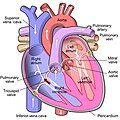Tricuspid valve
A valve in the heart between the right atrium and right ventricle
Tricuspid valve[edit]
The tricuspid valve is one of the four main heart valves in the human heart. It is located between the right atrium and the right ventricle. The valve's primary function is to prevent the backflow of blood from the right ventricle into the right atrium during ventricular systole.



Anatomy[edit]
The tricuspid valve is composed of three cusps or leaflets: the anterior, posterior, and septal cusps. These leaflets are attached to the fibrous ring known as the annulus. The valve is supported by the chordae tendineae, which are tendinous cords that connect the leaflets to the papillary muscles in the right ventricle.
Function[edit]
During the cardiac cycle, the tricuspid valve opens to allow blood to flow from the right atrium into the right ventricle during diastole. It closes during systole to prevent the backflow of blood as the right ventricle contracts and pumps blood into the pulmonary artery.
Clinical significance[edit]
File:Tricuspid Valve Disease.webm The tricuspid valve can be affected by various diseases, including tricuspid regurgitation, where the valve does not close properly, and tricuspid stenosis, where the valve opening is narrowed. These conditions can lead to symptoms such as fatigue, swelling, and heart failure.
Diagnosis and treatment[edit]
Diagnosis of tricuspid valve disorders often involves echocardiography, which uses ultrasound to visualize the heart's structure and function. Treatment may include medications to manage symptoms or surgery to repair or replace the valve.
Related pages[edit]
Gallery[edit]
-
Comparison with mitral valve insufficiency
Ad. Transform your life with W8MD's Budget GLP-1 injections from $75


W8MD offers a medical weight loss program to lose weight in Philadelphia. Our physician-supervised medical weight loss provides:
- Weight loss injections in NYC (generic and brand names):
- Zepbound / Mounjaro, Wegovy / Ozempic, Saxenda
- Most insurances accepted or discounted self-pay rates. We will obtain insurance prior authorizations if needed.
- Generic GLP1 weight loss injections from $75 for the starting dose.
- Also offer prescription weight loss medications including Phentermine, Qsymia, Diethylpropion, Contrave etc.
NYC weight loss doctor appointmentsNYC weight loss doctor appointments
Start your NYC weight loss journey today at our NYC medical weight loss and Philadelphia medical weight loss clinics.
- Call 718-946-5500 to lose weight in NYC or for medical weight loss in Philadelphia 215-676-2334.
- Tags:NYC medical weight loss, Philadelphia lose weight Zepbound NYC, Budget GLP1 weight loss injections, Wegovy Philadelphia, Wegovy NYC, Philadelphia medical weight loss, Brookly weight loss and Wegovy NYC
|
WikiMD's Wellness Encyclopedia |
| Let Food Be Thy Medicine Medicine Thy Food - Hippocrates |
Medical Disclaimer: WikiMD is not a substitute for professional medical advice. The information on WikiMD is provided as an information resource only, may be incorrect, outdated or misleading, and is not to be used or relied on for any diagnostic or treatment purposes. Please consult your health care provider before making any healthcare decisions or for guidance about a specific medical condition. WikiMD expressly disclaims responsibility, and shall have no liability, for any damages, loss, injury, or liability whatsoever suffered as a result of your reliance on the information contained in this site. By visiting this site you agree to the foregoing terms and conditions, which may from time to time be changed or supplemented by WikiMD. If you do not agree to the foregoing terms and conditions, you should not enter or use this site. See full disclaimer.
Credits:Most images are courtesy of Wikimedia commons, and templates, categories Wikipedia, licensed under CC BY SA or similar.
Translate this page: - East Asian
中文,
日本,
한국어,
South Asian
हिन्दी,
தமிழ்,
తెలుగు,
Urdu,
ಕನ್ನಡ,
Southeast Asian
Indonesian,
Vietnamese,
Thai,
မြန်မာဘာသာ,
বাংলা
European
español,
Deutsch,
français,
Greek,
português do Brasil,
polski,
română,
русский,
Nederlands,
norsk,
svenska,
suomi,
Italian
Middle Eastern & African
عربى,
Turkish,
Persian,
Hebrew,
Afrikaans,
isiZulu,
Kiswahili,
Other
Bulgarian,
Hungarian,
Czech,
Swedish,
മലയാളം,
मराठी,
ਪੰਜਾਬੀ,
ગુજરાતી,
Portuguese,
Ukrainian
